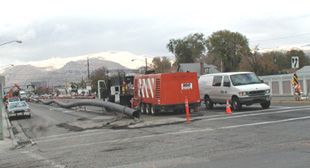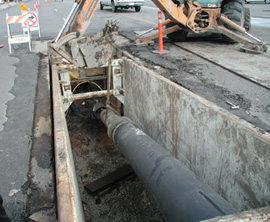Pipe Bursting
Salt Lake City Utilizes an Alternative to Digging up Streets
Charles H. Call, Jr., P.E.
November 25, 2005
|
During the summer of 2003 there were a number of breaks on a 4,000 foot segment of 16-inch cast iron pipe located on 300 West Street from 800 to 1300 South. These new breaks along with the historic record of breaks on this pipe segment led Public Utilities to the conclusion that it was necessary to replace 4,000 feet of pipe. Non-traditional methods such as pipe bursting have been receiving more attention in the literature as viable alternatives to the traditional open trench replacement. The process is applicable for cast iron pipe. After a careful evaluation, Public Utilties decided to use pipe busting technology for this project.
Pipe Bursting Technology
The method chosen was pneumatic pipe bursting. It is accomplished by pulling a pneumatic bursting device through the existing 16-inch cast iron pipe. This device by virtue of its size and the percussion action shatters the old pipe and forces the fragments into the surrounding soil. A new high-density polyethylene pipe (HDPE) is attached to the bursting head and is pulled into place as the device advances.
This method uses a compressor and air hose that charges the percussion head from behind and a cable that pulls from the front. A high strength cutting head was also attached to the front of the bursting head to cut away the cast iron pipe.
"We have had to dig out several sections of ductile iron pipe and provide some air gaps at pipes that cross over this waterline but this project is going real well. One of the big advantages for the City is that this Poly pipe (HDPE) is all in one piece, no joints to worry about" said Ron Brahs, Project Superintendent for the Contractor, Affholder, Inc. "Our winch has a 20-ton capacity and we've only had to use 4-tons to pull this pipe through."
|
Benefits
In the past Public Utilties' solution to deteriorating mains has been to repair them with stainless steel repair clamps and ductile iron sleeves. The cost of repair and the damage from emergency breaks has led the department to look at alternatives, including replacement and pipe bursting. The old cast iron system suffered numerous water main breaks. Most of the breaks can be attributed in some fashion to graphitization and electrolysis of the unprotected cast iron mains.
Jeff Mattson, the City's corrosion consultant said, "The big factor in this location is soil corrosivity and graphitization corrosion. Cast iron has a high percentage of carbon in the alloy, which causes the iron to sacrifically corrode, leaving the carbon behind which weakens the pipe because of carbon's low strength. Corrosive soils create a big underground battery on the waterlines. When there is a high groundwater table or deicing road salt, the battery works even harder, which speeds up the metal consumption rate on the cast iron waterlines."
Pipes can be replaced without digging a trench. This saves time and money and minimizes public and traffic disruptions. The old pipe is left underground eliminating the need for its disposal.
Typical Pipe Bursting Setup
During the pneumatic pipe bursting procedure, the pneumatic bursting head is placed into the host pipe at an entry pit or manhole. A winch cable is positioned at the exit area pit and attached to the head of the tool. A constant tension is applied and it guides the bursting head through the host pipe. Continuous percussion from the pneumatic tool fractures the host pipe. It effectively "hammers" its way through the host pipe, displacing the fragments into the surrounding soil, while simultaneously pulling the new HDPE pipe into place behind it.
Pipe bursting is becoming very effective in areas that are environmentally sensitive, high traffic areas, crossings such as highways, roads, railways, waterways and crossing private property where surface restoration can be costly.
Pneumatic Pipe Bursting Process
- Pneumatic pipe bursting is like driving a nail through wood with a hammer. Repeated blows progress the nail through straight and clean.
- The bursting tool is placed into the host pipe at an entry pit or manhole. A constant tension winch, based at the exit area pit and attached to the head of the tool, guides it through the host pipe. Continuous percussion from the pneumatic tool fractures the host pipe.
- The bursting tool effectively hammers its way through the host pipe, displacing the fragments into the surrounding soil, while simultaneously pulling the new pipe into place behind it. Pipe bursting allows for the upsizing of the original pipe.
- The winch plays a key roll in pipe bursting operations. The constant tension, variable speed winch makes adjustments for conditions that affect line speed during operation, providing constant and consistent pulling force and preventing slack from developing in the line, essentially guides the tool through the host pipe.

